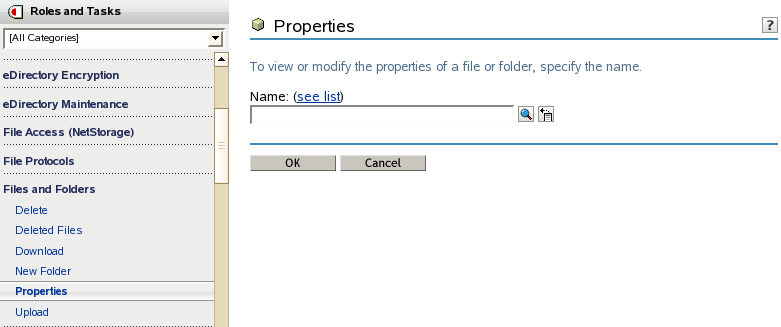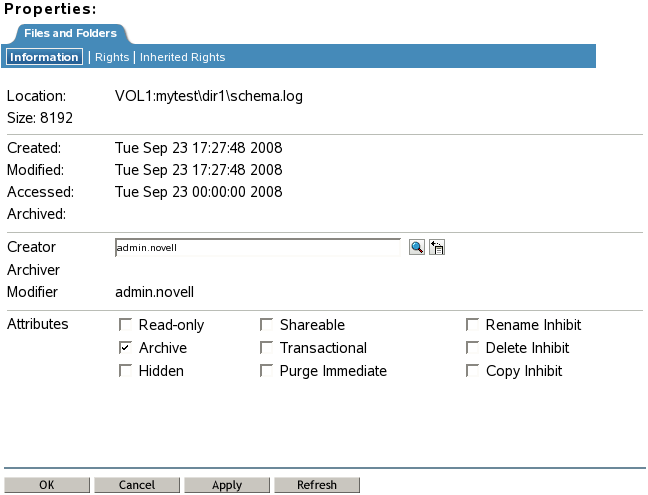28.5 Viewing or Modifying File or Folder Properties
-
In iManager, click > to open the page.

-
Click the icon to browse the Storage objects, locate and select the name link of the file or folder you want to manage, then click to view the Properties for the file.

-
Click the tab to view or modify the following information for the selected folder or file:
Property
Description
Location
The pathname of the selected volume, folder, or file. For example:
VOL1:dir1\dirB\filename.ext
Restrict Size
(Enable or Disable a Directory Quota on a Folder)
Enable (select) or disable (deselect) a directory quota on the specified folder on an NSS volume where the Directory Quotas attribute is enabled. The default is Disabled.
If this option is enabled, you must also specify a value for the quota in the Limit field.
A directory quota limits the amount of space on a volume that can be consumed by all of the files and folders in that directory. The directory quota applies to files and folders created by any user of the directory.
Select to enable a directory quota for the selected folder, specify the quota value in , then click .
Deselect to disable a directory quota for the selected folder, then click .
Limit
(Set Limit for a Directory Quota on a Folder)
The maximum size allowed for the specified directory and its contents.
Default: Disabled (not available unless is enabled).
If you enable for the selected folder, you must specify a limit for the directory quota. Type a value in KB for the quota. The value must be an increment of 4 KB; that is, it must be divisible by 4 with no remainder. Click to save the changes.
If the directory quota exceeds the volume quota, the volume quota is enforced.
If the current size of the selected folder exceeds the specified limit, users cannot save data to the folder until space is cleared by removing files from it.
If a user quota is set for a user on the volume, the user space restriction overrides the directory quota. That is, the user cannot save data to the folder if doing so causes the user to exceed his or her user quota.
Created
The time stamp (MM/DD/YYYY hh:mm) for when the file or folder was created.
Modified
The time stamp (MM/DD/YYYY hh:mm) for when the file or folder was last modified.
Accessed
The time stamp (MM/DD/YYYY hh:mm) for when the file or folder was last accessed.
Archived
The time stamp (MM/DD/YYYY hh:mm) for when the file or folder was last archived.
Creator
(View or Modify Ownership)
The typeless distinguished Novell eDirectory™ username (such as username.context) of the user who created the file or folder. If the username becomes invalid, such as if an employee leaves the company, the GUID of the username is reported. For NSS, any number of files or folders can be represented by GUIDs instead of valid usernames.
User quotas for NSS volumes consider file ownership to enforce user space restrictions. You might need to change the ownership of a file or folder in order to make the space it consumes be charged against a different user.
For NSS volumes (as for all volumes that use the Novell trustee model of access), all access to data is controlled by file system trustees and trustee rights instead of by ownership. When a user creates a file or folder, the trustees and trustee rights for accessing the file are automatically inherited from the directory where the file is created. If you intend different trustees and rights for the file, you must assign them explicitly by user, or assign the rights to a group and put the users into that group. For instructions, see Section 22.1.4, Configuring Rights Properties (File System Trustees, Trustee Rights, and Inherited Rights Filter).
Changing the ownership of the file or folder does not modify who can access it, but it does modify whose username is charged for the space it consumes. If you modify the ownership, you must click Apply or OK to save the changes.
Archiver
The distinguished username (such as username.context) of the user who modified the version of the file or folder that was last archived.
Modifier
The distinguished username (such as username.context) of the user who last modified the current version of the file or folder.
Attributes
File attributes determine how the file or folder behaves when accessed by any user. Enable or disable an attribute by selecting or deselecting the check box next to it. If you modify a setting, click or to save the changes.
File attributes apply universally to all users. For example, a file that has a read-only attribute is read-only for all users.
Attributes can be set by any trustee with the Modify right to the directory or file, and attributes stay set until they are changed. Attributes do not change when you log out or when you down a file server.
For example, if a trustee with the Modify right enables the Delete Inhibit attribute for a file, no one, including the owner of the file or the network administrator, can delete the file. However, any trustee with the Modify right can disable the Delete Inhibit attribute to allow the file’s deletion.
The following table defines file system attributes and whether they apply to files, folders, or both files and folders.
-
If you modified any settings, click or to save your changes.